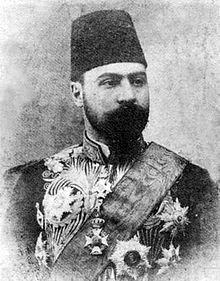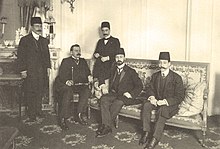Hassan Pirnia
Hassan Pirnia Moschir-al Dowleh ( Persian حسن پیرنیا مشیرالدوله; * 1872 ; † 1935 ) was a politician, minister and prime minister of Iran. Hassan Pirnia's term of office was marked by constant changes at the head of the state. The only constant factor was Defense Minister Reza Khan, who later became Reza Shah Pahlavi , who was to replace Hassan Pirnia as Prime Minister on October 28, 1923.
Life
Hassan Pirnia was the eldest son of Nasrollah Khan Moshir al Dowleh , a simple scribe who made it to prime minister under Mozaffar al-Din Shah .
Hassan attended school in Russia and spoke French fluently. Hassan Pirnia studied law in Russia. In 1902 he was sent to Russia as Mozaffar ad-Din Shah's ambassador. Back in Iran, he joined the constitutional movement . Hassan Pirnia drafted large parts of the 1906 constitution. He had translated several European constitutions into Persian and wrote a commentary on the genesis of the Persian constitution and its European roots.
After his father's death in 1907, he inherited the title of Moshir al Dowleh. From 1907 to 1908 Hassan Pirnia was Foreign Minister and later Minister of Justice.
Hassan Pirnia became Prime Minister for the first time in 1915. He was to take over the office in 1920, 1922 and 1923.
Hassan Pirnia is credited with overturning the 1919 Anglo-Persian treaty that would have made Iran a British protectorate. He delayed the vote in Parliament and refused to accept the £ 2 million loan associated with the contract.
After taking office as Prime Minister, Pirnia sent a delegation to Moscow in 1920 to put the relations between the Soviet Union and Iran, which had been interrupted after the collapse of Tsarist Russia, on a new contractual basis. The result was the Soviet-Persian friendship treaty signed in March 1921 , which led to the withdrawal of Soviet troops from northern Iran.
Another significant decision made by Hassan Pirnia was the appointment of Mehdi Qoli Khan Hedayat as governor of Azerbaijan . Two governors had already been dismissed from Azerbaijan without having achieved anything after they either failed to take office or were chased out of the city after a few days because of the great resistance in the population. Under the leadership of Sheikh Mohammad Khiabani , a separatist movement had formed that wanted to make Azerbaijan an autonomous area of the central government. After direct negotiations with Khiabani had failed, Hedayat ordered the local Cossack unit and the gendarmes to arrest Khiabani on September 13, 1920. After a four-hour gun battle, Khiabani was shot dead in the course of his arrest.
In northern Iran, Pirnia had less success in suppressing the separatist movement of Mirza Kuchak Khan . The Persian Cossack Brigade was led by Russian officers even after the October Revolution . The Anglo-Persian treaty of 1919 stipulated that the Russian commanding officers of the Persian Cossacks should be replaced by British officers, but Pirnia refused to comply. Instead, he ordered the Cossack commander Starosselsky to attack the Jangali rebels in northern Iran. In mid-August the Cossacks had taken Rasht , but they did not succeed in taking the port on the Caspian Sea, Bandar Anzali, which was important for the rebel supplies . They lost the decisive battles on August 25, 1920 and had to withdraw with heavy losses.
After this defeat, there was a dispute between Hassan Pirnia and the British ambassador about the dismissal of Starosselsky. The British insisted on his release. Hassan Pirnia threatened to resign. The British ambassador intervened with Ahmad Shah , who was demanding a monthly payment of 15,000 tomans until he left for Europe if he were to take any action on the matter. Obviously an agreement was reached. Starosselsky received 50,000 tomans in large bills from the British Imperial Bank of Persia , of which he gave 40,000 tomans to Ahmad Shah. Starosselsky left the country, Hassan Pirnia resigned and Ahmad Shah appointed Sepahdar as the new Prime Minister in October 1920.
After Seyyed Zia al Din Tabatabai's resignation on May 23, 1921, Ahmad Shah offered Hassan Pirnia again the office of Prime Minister, Hassan Pirnia declined. He preferred to remain an independent MP. Ahmad Qavam took over the post of Prime Minister. Reza Khan, who later became Reza Shah Pahlavi , became Minister of Defense. Qavam's term of office was only to last until February 1922. After all, Qavam had managed to get Arthur Millspaugh into the country, which meant that in the following years the Persian state had the financial means that were really necessary to build an orderly state.
After Qavam's resignation, Hassan Pirnia again took over the post of Prime Minister in February 1922. Reza Khan remained Minister of Defense. Another important appointment was Abdolhossein Teymurtasch , who took over the office of Minister of Justice. Pirnia's goal was a comprehensive judicial reform. However, this should not happen during Pirnia's term of office. Due to the continuing tension between Reza Khan and Hassan Pirnia over the amount of the defense budget, Pirnia resigned on May 25, 1922 and Ahmad Qavam took over the post of Prime Minister again in June 1922. Reza Khan had continued the Prime Minister's office until Qavam took over the post. Reza Khan also remained Minister of Defense in the Qavam cabinet. Through his successes in suppressing separatist movements in the north and west of Iran and building a powerful army, Reza Khan had considerably strengthened the decision-making power of the central government in Tehran over the provinces. During Qavam's reign, he wanted to take action against the separatist movements in southern Iran. An important goal of Qavam was to reach an economic agreement with the Soviet Union. After this failed because of the Soviet demands for an oil concession in northern Iran, which Qavam refused to grant, Qavam resigned on January 26, 1923. Hassan Mostofi took over the post of Prime Minister on February 14, 1923 . Reza Khan remained Minister of Defense. Mohammad Ali Foroughi became Foreign Minister. Hassan Mostofi had a strong opposition in parliament from the start, led by Hassan Modarres . In addition, there was no backing from Ahmad Shah, so that Mostofi resigned in June 1923 and Hassan Pirnia took over the post of prime minister again. Reza Khan would have liked to become prime minister, but his candidacy was completely hopeless at this point, as he did not have a majority in parliament. Ahmad Shah was also against a Prime Minister Reza Khan at this point. So Reza Khan remained Minister of Defense. After Hassan Pirnia submitted his resignation on October 23, 1923, Ahmad Shah had no more choice, and Reza Khan was appointed Prime Minister on October 28.
After retiring from active politics, Hassan Pirnia wrote a book on the pre-Islamic history of Iran .
Individual evidence
- ^ Cyrus Ghani: Iran and the rise of Reza Shah. IBTauris, 2000, p. 251.
- ^ Cyrus Ghani: Iran and the rise of Reza Shah. IBTauris, 2000, pp. 103f.
- ^ Cyrus Ghani: Iran and the rise of Reza Shah. IBTauris, 2000, p. 99.
- ^ Cyrus Ghani: Iran and the rise of Reza Shah. IBTauris, 2000, p. 226.
- ^ Cyrus Ghani: Iran and the rise of Reza Shah. IBTauris, 2000, pp. 250-288.
See also
| personal data | |
|---|---|
| SURNAME | Pirnia, Hassan |
| BRIEF DESCRIPTION | Iranian politician and Prime Minister of Iran |
| DATE OF BIRTH | 1872 |
| DATE OF DEATH | 1935 |


